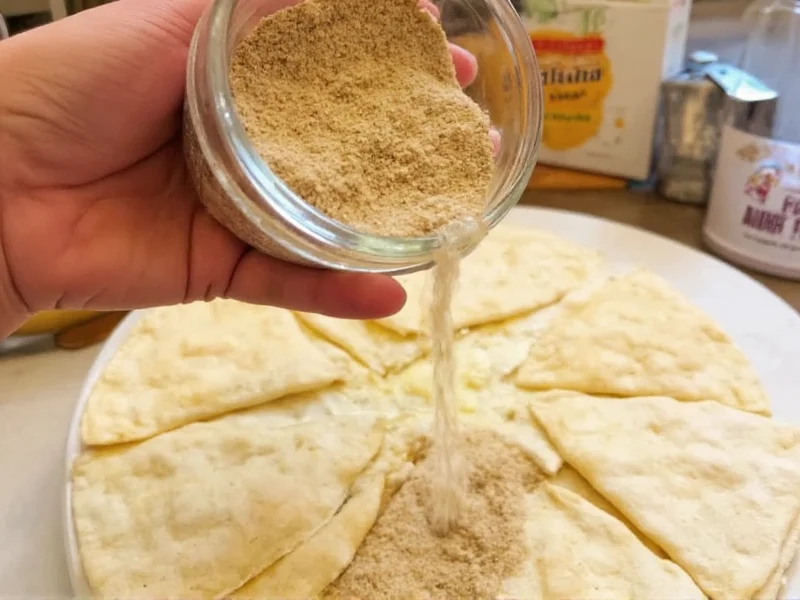Creating your own quesadilla seasoning puts you in control of flavor intensity and ingredient quality. Unlike store-bought versions that often contain fillers and excessive sodium, a homemade blend delivers fresher, more vibrant taste while accommodating dietary preferences. The beauty of crafting your own mix lies in its simplicity—requiring just six pantry staples and two minutes of preparation time.
The Essential Components of Authentic Quesadilla Seasoning
Traditional quesadilla seasoning builds upon foundational Mexican spices while maintaining balance. The core ingredients work synergistically: chili powder provides earthy warmth, cumin adds depth, garlic and onion powders contribute savory notes, paprika brings mild sweetness, and oregano offers herbal complexity. Salt enhances all flavors without dominating when used judiciously.
Unlike taco seasoning which tends to be bolder with higher cayenne content, quesadilla seasoning maintains a more subtle profile that complements rather than overpowers melted cheese—the star ingredient in any quesadilla. This distinction makes quesadilla-specific blends preferable for cheese-focused preparations.
Perfect Homemade Quesadilla Seasoning Recipe
This foolproof recipe yields enough seasoning for approximately eight standard quesadillas. The measurements balance traditional flavors while allowing customization based on personal heat preference and intended use.
| Ingredient | Measurement | Flavor Contribution |
|---|---|---|
| Chili powder | 2 tablespoons | Earthy base note |
| Ground cumin | 1 tablespoon | Warm, nutty depth |
| Garlic powder | 1½ teaspoons | Savory umami foundation |
| Onion powder | 1½ teaspoons | Sweet aromatic base |
| Smoked paprika | 1 teaspoon | Subtle smokiness |
| Dried oregano | ½ teaspoon | Herbal complexity |
| Sea salt | ¾ teaspoon | Flavor enhancer |
| Black pepper | ¼ teaspoon | Subtle heat |
Customizing Your Quesadilla Spice Blend
Regional Mexican cuisine features significant variation in spice preferences. Consider these authentic adjustments based on your desired flavor profile:
- Northern Mexico style: Increase cumin by 50% and add ¼ teaspoon dried thyme for earthier notes that complement grilled meats
- Central Mexico approach: Incorporate ⅛ teaspoon Mexican oregano and a pinch of cinnamon for subtle complexity
- Milder version: Replace half the chili powder with additional paprika for family-friendly quesadillas
- Spicy variation: Add ⅛-¼ teaspoon cayenne pepper or chipotle powder for smoky heat
For gluten-free quesadilla seasoning, verify all spice containers are certified gluten-free as cross-contamination sometimes occurs during processing. Vegan quesadilla seasoning requires no modifications since traditional blends contain no animal products.
Optimal Usage Techniques for Maximum Flavor
Understanding how to apply quesadilla seasoning properly makes the difference between good and exceptional results. For cheese quesadillas, sprinkle 1-1½ teaspoons of seasoning per tortilla directly onto the cheese layer before folding. When incorporating proteins, coat chicken or steak with 1 tablespoon seasoning per pound before cooking.
The timing of application matters significantly. Adding seasoning to cold cheese allows flavors to meld during melting, while applying to proteins before cooking creates a flavorful crust. Never sprinkle seasoning directly onto hot cooking surfaces as this burns delicate spices and creates bitter notes.
Proper Storage for Long-Lasting Freshness
Homemade quesadilla seasoning maintains peak flavor for 2-3 months when stored properly. Transfer your blend to an airtight glass container away from heat and light. Avoid storing near your stove or in clear containers on spice racks exposed to sunlight, as both conditions accelerate flavor degradation.
For extended shelf life up to six months, divide your seasoning into smaller portions and freeze what you won't use within three weeks. Thaw frozen seasoning at room temperature for 30 minutes before use to prevent condensation inside your container. Always use dry utensils when measuring to prevent moisture introduction.
Comparing Homemade vs Commercial Quesadilla Seasoning
While convenient, store-bought quesadilla seasoning often contains anti-caking agents, excessive sodium (typically 200-300mg per serving), and artificial preservatives. A side-by-side comparison reveals significant differences:
- Flavor control: Homemade allows precise adjustment of heat level and salt content
- Ingredient quality: You select fresh, high-grade spices rather than potentially stale commercial blends
- Cost efficiency: Making your own costs approximately 15-20 cents per batch versus $2-3 for commercial packets
- Dietary customization: Easily adapt for low-sodium, salt-free, or specific allergy needs
Creative Applications Beyond Traditional Quesadillas
Don't limit your quesadilla seasoning to just tortilla pockets. This versatile blend enhances numerous dishes:
- Season roasted vegetables (especially sweet potatoes and zucchini)
- Boost flavor in bean dips and hummus
- Enhance scrambled eggs or omelets
- Add to tomato-based pasta sauces for Mexican-Italian fusion
- Season popcorn for a flavorful snack
- Boost flavor in soups and stews
For quick weeknight dinners, toss 2 tablespoons of quesadilla seasoning with cooked rice, black beans, corn, and diced tomatoes for an instant Mexican rice bowl. The seasoning also works beautifully as a dry rub for grilled vegetables or as a flavor enhancer in homemade tortilla chips.











 浙公网安备
33010002000092号
浙公网安备
33010002000092号 浙B2-20120091-4
浙B2-20120091-4